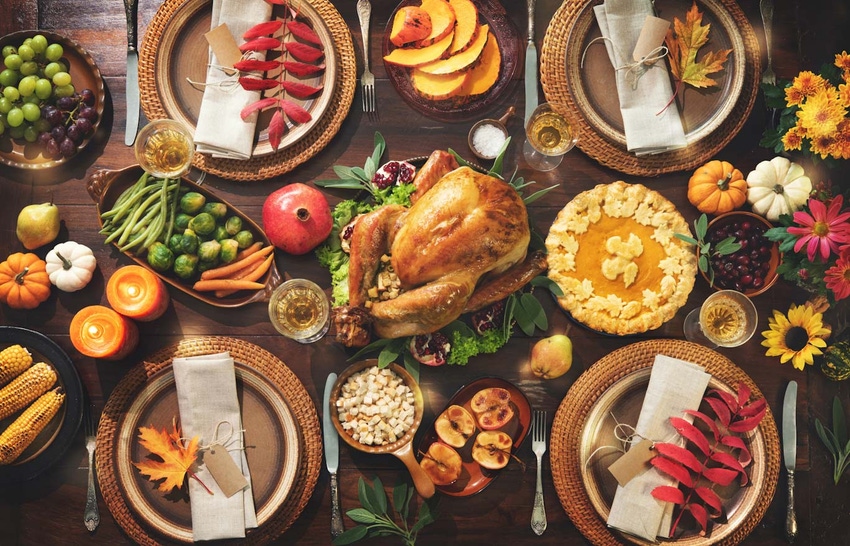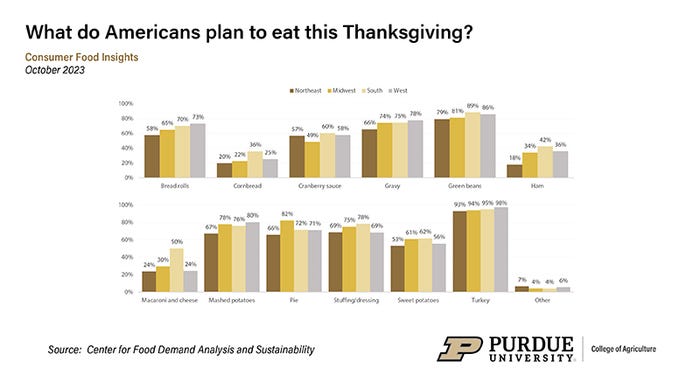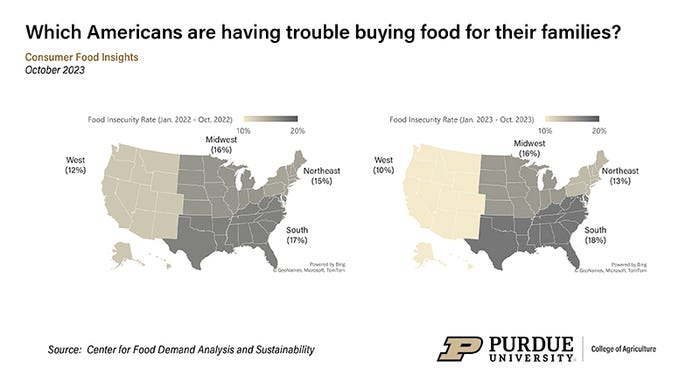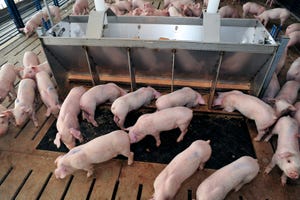Food price inflation top of mind this Thanksgiving
Staples like turkey, green beans and stuffing common in all regions; cornbread, ham and macaroni and cheese more likely in the South.
November 21, 2023

Nearly eight in 10 Americans will celebrate the upcoming Thanksgiving holiday with a special meal, according to the October 2023 Consumer Food Insights Report.
The survey-based report out of Purdue University’s Center for Food Demand Analysis and Sustainability assesses food spending, consumer satisfaction and values, support of agricultural and food policies, and trust in information sources. Purdue experts conducted and evaluated the survey, which included 1,200 consumers across the U.S.
“We found that 79% of consumers plan on celebrating the holiday with a Thanksgiving meal while 13% do not and 9% are unsure,” said the report’s lead author, Joseph Balagtas, professor of agricultural economics at Purdue and director of CFDAS. Of those celebrating with a meal, 37% plan to host, 43% plan to attend and 5% plan to eat out. The remaining 14% are unsure of their Thanksgiving meal plans.

In October the center broke down the data by the four major U.S. Census regions: Northeast, Midwest, South and West. Regionally, there were few differences in consumer expectations for the upcoming holiday.
“Those hosting expect higher turkey prices relative to last year and plan to budget more for this year’s meal,” Balagtas said. “In fact, retail prices for whole turkeys are down 10% to 15% from last year’s record high prices, as turkey production has recovered from the avian influenza outbreak. But our survey suggests food price inflation is still top of mind for consumers.
“Interestingly, we see a disconnect between the responses of hosts and attendees when asking about sharing the burden of the meal,” Balagtas said. “Fewer hosts are willing to ask guests to bring part of the meal or share the meal expenses than the number of attendees who are willing to bring part of the meal or help with meal expenses.”
This is unsurprising, given previous psychological research into the difference between the willingness to ask for help and the willingness of others to help, he noted.
The survey also revealed regional differences in the frequency that certain foods would be on the table this Thanksgiving, said Elijah Bryant, a survey research analyst at the center and co-author of the report.

“While Thanksgiving staples like turkey, green beans, gravy and stuffing will be common meal components in all regions, items such as cornbread, ham, and macaroni and cheese are more likely to be a part of meals in the South compared to the other three regions,” Bryant said.
Food spending varies by region, likely because of differences in the cost of living. Average weekly spending is highest in the Northeast region ($201) and lowest in the Midwest ($177). Notably, average weekly spending between January and October 2023 rose more than $10 in the Midwest, South and Northeast regions compared to 2022.
“The higher food spending is likely a result of rising food prices forcing consumers to budget more to purchase their typical basket of grocery items. Households that aren’t spending more this year are likely buying less or substituting in more affordable food items to keep costs down,” Bryant said.
The survey found that 13.3% of households were food insecure in October, the lowest reading recorded through the first 10 months of 2023.
“It’s a good thing that the food insecurity rate is down from the higher rates we saw in the spring and summer. But as many of us get ready to celebrate Thanksgiving, this is a reminder that approximately one in eight Americans lack consistent access to adequate food,” Balagtas said.
Food insecurity rates vary by region. The largest difference so far in 2023 occurs between the West (10%) and South (18%) regions. The prevalence of food insecurity is highest in the South, followed by the Midwest, Northeast and West. These findings are consistent with the USDA's Economic Research Service’s food insecurity statistics.
Diet well-being appears to correlate with food insecurity. Consumers living in more food-secure regions tend to rank their diets higher on the diet well-being index.
Slightly more consumers in the West and Northeast, which are the regions with the lowest prevalence of food insecurity, are categorized as “thriving” on the diet well-being index compared to the South and Midwest.
“However, most consumers, regardless of region, are ‘rather happy’ or ‘very happy’ with their diets, showing the ability of the U.S. food system to satisfy the diets of consumers from all regions of the U.S.,” Bryant said.
The Center for Food Demand Analysis and Sustainability is part of Purdue’s Next Moves in agriculture and food systems and uses innovative data analysis shared through user-friendly platforms to improve the food system. In addition to the Consumer Food Insights Report, the center offers a portfolio of online dashboards.
You May Also Like



